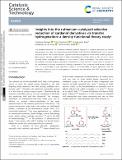Insights into the ruthenium-catalysed selective reduction of cardanol derivatives via transfer hydrogenation : a density functional theory study
Abstract
The detailed mechanism for ruthenium-catalysed selective reductionof cardanol derivatives by transfer hydrogenation has been fully characterisedat the B3PW91-D3/ECP2/PCM//B3PW91/ECP1 level of density functional theory. The explored catalytic cycle involved the hydrogenation of the triene cardanolgiving the diene product through a highly stable η3-allylicintermediate via a kinetic barrier of 29.1 kcal mol−1, which followed further hydrogenation leading to a more stable η3-allylicintermediate. The further reduction to the cardanol monoene product required an overall barrier of 29.2 kcal mol−1, which offers a rationale for the requirement of elevated temperatures (refluxing isopropanol). The computed overall barrier of 46.6 kcal mol−1 to accommodate a fully saturated product is unsurmountable— in good agreement with the experiment, where no such full hydrogenation is observed, and rationalising the 100% selectivity towards the monoene product.
Citation
Ahmad , S , Crawford , E , Bilal , M , de Vries , J G & Buehl , M 2023 , ' Insights into the ruthenium-catalysed selective reduction of cardanol derivatives via transfer hydrogenation : a density functional theory study ' , Catalysis Science & Technology , vol. 13 , no. 9 , pp. 2662-2674 . https://doi.org/10.1039/D3CY00135K
Publication
Catalysis Science & Technology
Status
Peer reviewed
ISSN
2044-4753Type
Journal article
Description
Funding: Authors thank EaStCHEM and the School of Chemistry for their support.Collections
Items in the St Andrews Research Repository are protected by copyright, with all rights reserved, unless otherwise indicated.

